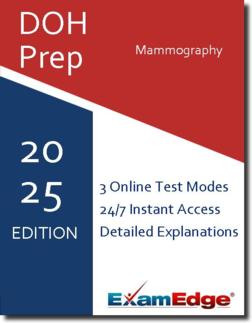DOH Mammography (DOH-Mamm) Practice Tests & Test Prep by Exam Edge - Test Reviews
Based on 17 Reviews
- Real Exam Simulation: Timed questions and matching content build comfort for your DOH Mammography test day.
- Instant, 24/7 Access: Web-based DOH Mammography practice exams with no software needed.
- Clear Explanations: Step-by-step answers and explanations for your DOH exam to strengthen understanding.
- Boosted Confidence: Reduces anxiety and improves test-taking skills to ace your DOH Mammography (DOH-Mamm).

DOH Mammography (DOH-Mamm) Practice Tests & Test Prep by Exam Edge - Review
DOH Mammography - Reviews
Excellent
Based on
85
reviews
“ I took the exam and failed because I didn't review well and didn't know which topics to focus on, but after purchasing these 20 sets from haadrn.Com, I passed my second exam. I only finished up to 17 sets, I am thankful for this site because I can review online anytime, anywhere! Friends are asking ...
Read More
parrenas, Philippines
“ Thank you Exam Edge :) I passed the Haad RN exam :) Godbless :)
Fedi, Manila, Philippines
“ I just want to take this opportunity to thank Exam Edge since I passed my HAAD exam.
RHODALYN,
“ I am glad to inform you that I have successfully passed my HAAD ophthalmology exams, your mock tests were extremely helpful in my journey to this success, thank you once again
Farheen, Karnataka India
See why our users from 154 countries love us for their exam prep! Including 17 reviews for the DOH Mammography exam.
Exam Edge is an Industry Leader in Online Test Prep. We work with our Institutional Partners to offer a wide array of practice tests that will help you prepare for your big exam. No Matter how niche field of interest might be, were here to help you prepare for your test day.
| 2.8M | 4.5M | |
| Users | Tests Taken | |
| 100K | 19 | |
| Unique Exams | Years in Business | |


